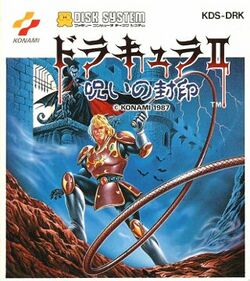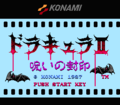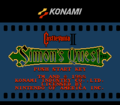
| Castlevania II: Simon's Quest | |
|---|---|
| Developer(s) | Konami |
| Publisher(s) | Konami |
| Year released | 1987 |
| System(s) | Family Computer Disk System, NES, Wii, Nintendo 3DS, Wii U |
| Preceded by | Castlevania I |
| Followed by | Castlevania III: Dracula's Curse |
| Series | Castlevania |
| Japanese title | ドラキュラII呪いの封印 |
|---|---|
| Genre(s) | Role-playing game |
| Modes | Single player |
| Rating(s) |
- For the Game Boy game, see Castlevania II: Belmont's Revenge.
Castlevania II: Simon's Quest (ドラキュラII 呪いの封印 Dorakula 2: Noroi no Fuuin?, lit. "Dracula II: The Seal of the Curse") is an role-playing game produced by Konami. It was originally released for the Family Computer Disk System in Japan in 1987, and for the NES in North America in 1988. It is the second Castlevania title released for the NES, following the original Castlevania.
Story[edit]
Set in 1698, seven years after the events of the first installment, the player once again assumes the role of vampire hunter Simon Belmont, who is on a journey to undo a curse placed on him by Dracula at the end of their previous encounter.
The game's setting takes place seven years after the original Castlevania. The prologue begins when Simon visits his family's resting ground. His back is critically injured from his last encounter with Dracula in the previous game. He suddenly feels someone's presence, and turns to see a young woman standing within the mist. She tells him that a curse was placed upon him by Dracula during their last battle, and that he does not have long to live. The woman continues to say that the curse can be undone if he resurrects Dracula himself. She further explains that Dracula's body was split into five different parts after his defeat seven years ago, and Simon must recover these and bring them to the ruins of Dracula's castle. There, he must seal Dracula and defeat him. Before disappearing, the unknown woman says she cannot guarantee that this will destroy Dracula permanently.
Gameplay[edit]
Simon's Quest was the second game (after Vampire Killer) in the Castlevania series to depart from linear gameplay, and instead feature a non-linear explorative world, which has been compared to Nintendo's famous Metroid series. During the late 80s, a trend emerged where sequels of popular NES games contained gameplay differing significantly from the originals. Examples include Super Mario Bros. 2 and Zelda II: The Adventure of Link. Simon's Quest contained far more role-playing elements than the original, such as exploring towns, talking to people, buying weapons and items, and experience levels. It was not linear, allowing players to freely come and go from one area of the game to another. The game's exploration system and ideas introduced adventure elements to the series for the first time, and it would heavily influence future titles. The first game that drew inspiration from it was Castlevania: Symphony of the Night.
Reception[edit]
The game garnered positive reviews following its release, and received the reputation of a Nintendo classic over time. Numerous statements about the game also laud its graphical and audio presentation. Reviewers have remarked that it is "absolutely amazing", and have complimented its visuals for being an improvement over the first Castlevania.
Simon's Quest was not without its criticism. A common complaint about the game was its English localization. The clues offered by the characters in the game were criticised for being too cryptic and poorly translated. Producer of several Castlevania titles, Koji Igarashi, revealed in an interview that all the townsfolk in the Japanese version were deliberate liars. The subtle hints from the Japanese version were lost in translation.
Version differences[edit]
Small differences exist between the Japanese version and the American version. Specifically the Japanese version takes advantage of the expanded FM processing capabilities of the FDS hardware to produce better sound, but it contains load scenes when entering or exiting any town or mansion. The FDS version also has three save slots (similar to The Legend of Zelda), while the NES version uses passwords to allow a player to stop playing and pick up where they left off.
An infamous line of dialogue they gave as an example was "hit Deborah Cliff with your head to make a hole". Further criticism also stemmed from some of the game's puzzles, which reviewers have noted for not having any clues at all.
-
Original Japanese title screen
-
Localized American title screen
-
Japanese promotional flyer
-
American box art



